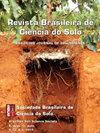Nitrogen release from pelletized poultry fertilizer in two soils: influence of soil moisture and microbial biomass
IF 2
4区 农林科学
Q3 SOIL SCIENCE
引用次数: 2
Abstract
Nitrogen release from organic amendments, e.g., from organic agriculture, is a key process to raise soil fertility to sustain crop production in low environmental impact agroecosystems. This study aimed to investigate nitrogen release from a pelletized organic amendment containing poultry litter, guano and pot ale applied to soil from a field under two different management systems: an alfalfa-based crop rotation, enriched with N by the legume, under low-intensity tillage and a cereal-sunflower crop rotation under high-intensity tillage. Both sample types were evaluated under different temperature and soil moisture conditions (optimal and variable). The influence of the released amount of N-NO3 on soil microbial biomass, soil basal respiration as well as on β-glucosidase, alkaline phosphatase and o-diphenoloxidase were investigated. The soil fertility level under low-intensity was higher than under high-intensity tillage. Consequently, compared to the control, microbial biomass growth in pellet-treated samples was intensified, both under optimal and variable conditions. Nevertheless, at the end of the experiment under variable conditions, microbial biomass decreased down to the level of the control. Soil moisture was identified as the limiting factor for basal respiration in low-tillage soil, while in the intensively tilled soil, low fertility was limiting, and respiration increased in response to pellet application, supplying C for microbial biomass. During the experimental period, the investigated enzyme activities were somewhat intensified by pellet application, contributing slightly to improve soil biochemical fertility. More N-NO3 was released from soil under low than high-intensity tillage; however after 90-days, the pellet was not completely mineralized, and even at optimal soil moisture content, nitrate release was only partial. This indicated that pelletizing, though useful for practical reasons such as handling, storage and field distribution, can reduce the fertilization efficiency of organic amendments.两种土壤中颗粒状家禽肥料氮释放:土壤水分和微生物量的影响
有机改良剂(例如有机农业)释放的氮是提高土壤肥力以维持低环境影响农业生态系统作物生产的关键过程。本研究旨在研究在两种不同管理制度下的土壤中施用含家禽废弃物、鸟粪和锅粪的颗粒状有机改进剂的氮素释放情况:低强度耕作下以苜蓿为基础的豆类富氮轮作和高强度耕作下谷物-向日葵轮作。两种样品类型在不同温度和土壤湿度条件下(最佳和可变)进行了评估。研究了N-NO3释放量对土壤微生物生物量、土壤基础呼吸以及β-葡萄糖苷酶、碱性磷酸酶和邻二酚氧化酶的影响。低强度耕作的土壤肥力水平高于高强度耕作。因此,与对照相比,在最佳和可变条件下,颗粒处理样品中的微生物生物量增长都得到了加强。然而,在实验结束时,在可变条件下,微生物生物量下降到对照水平。土壤水分是低耕土壤基础呼吸的限制因子,而在精耕细作土壤中,低肥力是限制因子,颗粒施用使土壤呼吸增加,为微生物生物量提供碳。在试验期间,施用颗粒对土壤生化肥力的提高有一定的促进作用。低强度耕作比高强度耕作释放出更多的N-NO3;然而,90天后,颗粒并未完全矿化,即使在最佳土壤含水量下,硝酸盐也只是部分释放。这表明,造粒虽然在处理、储存和田间分配等方面有用,但会降低有机改良剂的施肥效率。
本文章由计算机程序翻译,如有差异,请以英文原文为准。
求助全文
约1分钟内获得全文
求助全文
来源期刊

Revista Brasileira De Ciencia Do Solo
农林科学-土壤科学
CiteScore
3.00
自引率
11.80%
发文量
32
审稿时长
9-24 weeks
期刊介绍:
The Revista Brasileira de Ciência do Solo is a scientific journal published by the Brazilian Society for Soil Science (SBCS), founded in 1947, and is responsible for the propagation of original and inedited technical-scientific work of interest for Soil Science.
Contributions must not have been previously published or submit to other periodicals, with the only exception of articles presented in summarized form at professional meetings. Literature reviews are accepted when solicited by the Editorial Board.
 求助内容:
求助内容: 应助结果提醒方式:
应助结果提醒方式:


